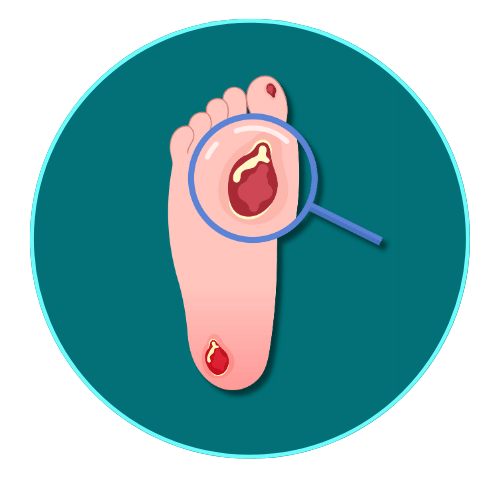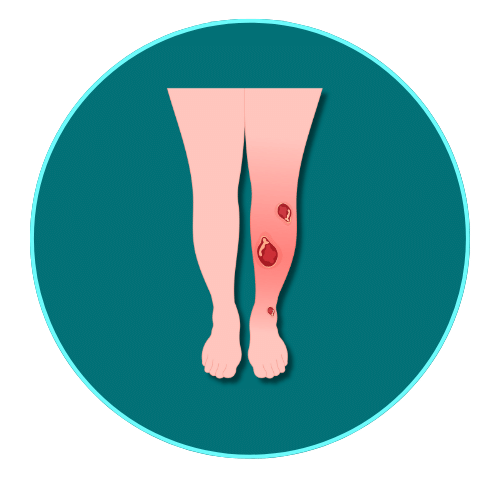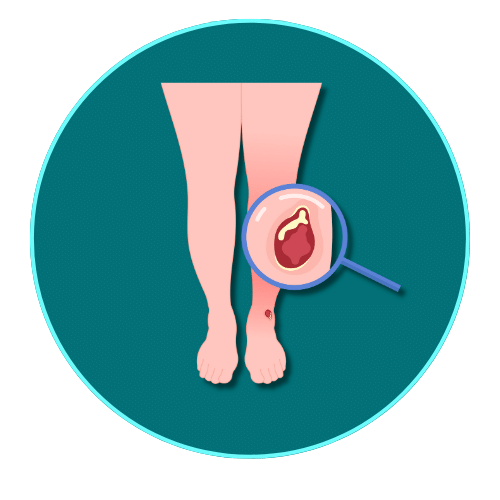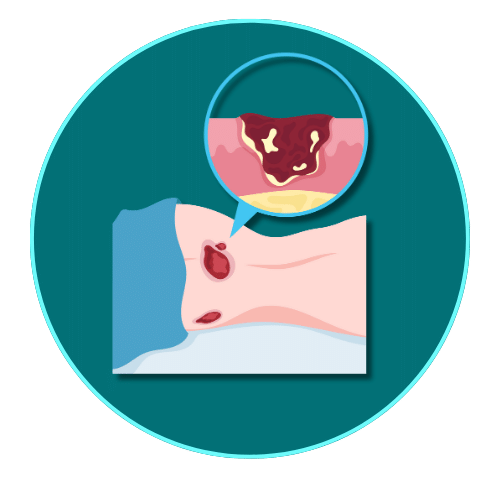WOUNDS THAT WON’T HEAL
CHRONIC ULCERS are wounds that don’t heal as quickly or as easily as they should. Left untreated, these wounds can cause infection, necrosis (death of tissue), amputations, and sepsis (widespread or life-threatening infection). Some wounds refuse to heal with standard treatments. Don’t despair! Most of these wounds can heal with expert care, and carefully following instructions. For those that still won't heal, there are newer advanced treatments available that will lead to healing with most wounds.
COMMON TYPES OF CHRONIC ULCERS

Diabetic (or neuropathic) foot wounds:
Over 25 million Americans are currently diagnosed with diabetes. Many millions more are not even aware that they have diabetes. Diabetes causes many changes in the body that lessen your ability to detect wounds that are forming and lessen your ability to heal those wounds. More than 15% of people with diabetes will develop diabetic foot ulcers. Diabetes is the most common of the many causes of peripheral neuropathy. That means that the small nerve fibers in your feet deteriorate, leading to numbness, and sometimes unusual pain. Our nerves are meant to detect areas of pressure or rubbing that would eventually damage the skin and tissue. The damaged nerves do not signal the brain and body to adjust to these areas of pressure, so the damage continues and creates a hot spot, callus, or blister that becomes an open wound.

Venous leg ulcers:
Leg veins and lymphatic vessels are designed to clear the blood and fluids from the legs and feet. When they no longer work correctly, the fluid builds up. Eventually, the skin and tissue of the legs are damaged by swelling, pressure, and accumulation of toxins the body produces. Once the skin becomes fragile, discolored, or leaks fluid, you are on your way to developing venous leg ulcers. These wounds can grow very large and are very difficult to heal or remain healed without specific treatments.

Arterial ulcers:
Narrowed, diseased, or blocked arteries cause poor blood flow into the legs and feet, robbing them of the nutrients and oxygen that is needed to sustain life. This causes the skin and tissue to die, especially on the toes or on areas of pressure, like sides of feet, ankles, and heels. These ulcers can be very painful, unless there is also nerve damage or neuropathy. These wounds will not heal without improving the blood flow. There are ways to temporarily increase blood flow that may be helpful in healing. However, these need restoration of circulation by a vascular specialist, as well as expert wound care to avoid amputation.

Pressure ulcers:
Pressure ulcers are commonly known as “bed sores.” Sustained pressure on a body part prevents blood flow, nutrients, and oxygen from reaching the area. The tissue dies and becomes an open wound or an area of dead tissue. This commonly happens to people who are confined to bed or a wheelchair, or those who fall and are stuck in one position for hours at a time. This can happen on heels, ankles, buttocks, hips, or any area that rests on the bed or chair.
Healing Chronic Ulcers: What's Needed?
- Minimize pressure & rubbing using specialized tools like insoles, shoes, and boots. Sometimes surgical correction of deformities is required.
- Regularly remove dead or dying tissue to revitalize stagnant wounds.
- Employ appropriate dressings. Maintain optimal moisture and ward off infections. Some dressings even speed up the healing process.
- Proactively treat and guard against infection. A festering wound can lead to dire outcomes like amputation.
- Counteract swelling with expert compression wraps. Lymphedema pumps and vein specialists can also aid in this.
- Revive blood circulation. Seek a vascular specialist if poor blood flow is a concern.
- Key health directives for wound healing: strictly manage diabetes, abstain from smoking and excessive alcohol, and ensure a nutritious diet. Once again for emphasis, do not smoke!
When Conventional Healing Fails, What Next?
Enter advanced wound treatments. So, what's in the toolkit?
- Cellular and Tissue Products: Previously known as bioengineered skin substitutes. They offer growth factors and scaffolding for new tissue. We utilize human amniotic membrane grafts, which offer these benefits plus stem cells for enhanced healing.
- Negative Pressure Wound Therapy (NPWT): Commonly dubbed “vac therapy.” It extracts excess fluids, discards toxic substances, and promotes tissue growth via a sealed suction system. We generally use discreet portable devices.
- Surgical Solutions: Remove the ulcer and graft healthier skin in its place. This can drastically speed up healing. Additionally, fixing bony abnormalities can prevent recurrence. Reconstructive surgery might also be on the table.

